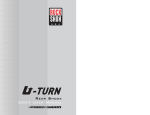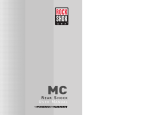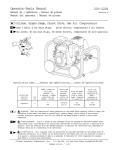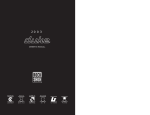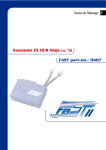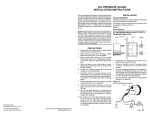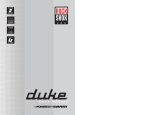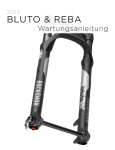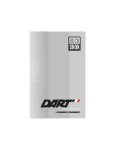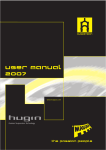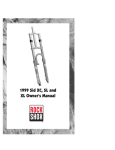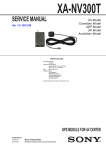Download 03 SID Rear Manual
Transcript
ADJUST REAR SHOCK 2004 U S E R M A N UA L SRAM CORPORATION • 2004 SID REAR ADJUST USER MANUAL ENGLISH Congratulations! You have the best in suspension components on your bicycle! This manual contains important information about the safe operation and maintenance of your shock. To ensure that your RockShox shock performs properly, we recommend you have a qualified bicycle mechanic service your shock. We also urge you to follow our recommendations to help make your bicycling experience more enjoyable and trouble-free. Rebound Adjustment Knob Au enliegender Einsteller f r Zugstufe Adjustador externo de rebote Bouton de rØglage externe du rebond Regolatore del ritorno Regolatore esterno del ritorno Shaft Eyelet / se an der F hrungsstange / Ojal del eje / illet de la tige /Occhiello albero / / Schacht-oogje / Olhal do pistªo Externe terugveringsknop Regulador externo de recupera ªo Positive Schrader Air Valve Positiv-Luftventil VÆlvula de aure positiva VÆlva air positive Valvola aria in pressione Klep positieve lucht VÆlvula de ar positivo (sem adaptador) Negative Schrader Air Valve Negativ-Luftfeder (ohne Adapter) VÆlvula de aire negative (sin adaptor) Valve air nØgative (sans adaptateur) Valvola aria in depressione (senza adattatore) Klep negatieve lucht (zonder adapter) VÆlvula de ar negativo (sem adaptador) Body Eyelet / se am Geh use / Ojal de la carcasa / illet du corps / Occhiello corpo / / Romp-oogje / Olhal do corpo Threaded Collar / Ring mit Gewinde / Casquillo roscado / Collier taraudØ / Collare filettato / / Stelring met schroefdraad Anilha roscada Air Can Beh lter CÆpsula Bo tier Contenitore Reservoir Inv lucro Body Geh use Carcasa Corps Corpo Romp Corpo NOTE: YOUR SHOCK’S APPEARANCE MAY VARY FROM THE ILLUSTRATIONS/PHOTOS IN THIS MANUAL. FOR THE LATEST INFORMATION ABOUT YOUR FORK VISIT OUR WEBSITE AT WWW.ROCKSHOX.COM. SRAM CORPORATION • APRIL 2003 3 SRAM CORPORATION • 2004 SID REAR ADJUST USER MANUAL ENGLISH I M P O R T A N T Consumer Safety Information SRAM CORPORATION • 2004 SID REAR ADJUST USER MANUAL S e l e c t i n g A i r P r e s s u r e ( Sp r i n g R a t e ) : 1. 2. RIDING A BIKE IS DANGEROUS. NOT PROPERLY MAINTAINING OR INSPECTING YOUR BIKE IS EVEN MORE DANGEROUS. IT’S ALSO DANGEROUS NOT TO READ THESE INSTRUCTIONS. 1. 2. 3. Before riding the bicycle, be sure the brakes are properly installed and adjusted. If the brakes don’t work properly, the rider could suffer serious and/or fatal injuries. If the shock ever loses oil or if it makes sounds of excessive topping out, stop riding the bicycle immediately and have the shock inspected by a dealer or call RockShox. Continuing to ride with the shock in either of these conditions could result in loss of control of the bicycle with possible serious and/or fatal injuries. Always use genuine RockShox parts. Use of after-market replacement parts voids the warranty and could cause structural failure to the shock. Structural failure could result in loss of control of the bicycle with possible serious and/or fatal injuries. ENGLISH Depressurize the positive and negative air chamber by removing the air cap and depressing the valve core stems. Because every bike is different, a good starting point is to pressurize the positive air chamber to an air pressure equaling your body weight. NOTE: AS BICYCLE DESIGNS DIFFER SIGNIFICANTLY, YOUR BICYCLE MAY REQUIRE DIFFERENT PRESSURES OR SET UP TECHNIQUES. THESE INSTRUCTIONS ARE INTENDED AS A GUIDELINE ONLY. 3. 4. 5. After adding air to your shock based on your body weight, and without sitting on the bike, measure the distance from the rear axle to the seat (rear height). Write it down. While you sit in a normal riding position, have a friend measure the same distance. The difference between the two measurements is sag. Determine what percentage of total wheel travel this sag represents. If the sag is less than your bicycle manufacturer’s recommendation, a lower air pressure should be used. If the sag is greater than your bike manufacturer’s recommendation, a greater air pressure should be used. IMPORTANT: DO NOT USE AIR PRESSURE OUTSIDE THE 100 TO 250 PSI RANGE. 6. Once sag has been set, pressurize the negative air chamber to match the positive air chamber pressure. TIP: ADJUSTING THE NEGATIVE AIR CHAMBER DETERMINES THE EASE OF INITIAL COMPRESSION. THE HIGHER THE AIR PRESSURE YOU PUT IN, THE EASIER IT IS TO COMPRESS THE SHOCK. I N S TA L L AT I O N It is extremely important that your RockShox rear shock is installed correctly by a qualified bicycle mechanic with proper tools. Consult your bicycle manufacturer’s instructions for proper installation of your rear shock. ! WARNING IMPROPERLY INSTALLED REAR SHOCKS CAN BE EXTREMELY DANGEROUS AND MAY RESULT IN SEVERE AND/OR FATAL INJURIES. 7. 8. Measure the sag once again to make sure it is the same. Write down the measurement and air pressure reading from the shock. Install both air caps. Example: If your bike has 4” of rear wheel travel and you want to set it up for cross-country riding, your sag should be 0.6 - 1.2 in. If you weigh 175 lb., pressurize the positive chamber to 175 psi and measure your sag. Then pressurize the negative air chamber to 175 psi and remeasure sag. NOTE: IT IS IMPORTANT THAT THE SHOCK HAS THE AIR VALVE CAPS ON AT ALL TIMES OR THE SHOCK CAN PREMATURELY LOSE AIR. Rebound Damping Adjustment (Some Models) PERFORMANCE TUNING RockShox rear shocks can be tuned for your particular weight, riding style, and terrain. IMPORTANT: BE SURE YOU TAKE YOUR BIKE FOR A TEST RIDE TO SEE IF THE REAR SHOCK IS SET UP FOR YOU STRAIGHT OFF THE SHOWROOM FLOOR. By adjusting the air pressure, the SID rear shock can be tuned for your particular weight, riding style, and terrain. You may benefit by making tuning adjustments to suit your specific needs. When tuning suspension, always make one change at a time and write it down. This allows you to understand how each change affects your ride. Setting Sag Sag is the amount of shock travel that is used as the rider sits stationary on the bike. Typically, sag is 15 to 30 percent of all available wheel travel. Check with your bicycle manufacturer to determine the rear wheel travel and recommended sag for your particular bike before setting sag. For the SID rear shock you will be changing the air spring rate to set sag. The shock includes a red rebound damping adjustment knob. Rebound is the extension or return stroke of the shock. Rebound damping adjustment allows you to control the rate at which the shock extends after it is compressed. The shock’s rebound is quickest when the adjustment knob is in the full counterclockwise position. Rebound is slowest when the adjustment knob is in the full clockwise position. SETTING REBOUND When you are setting rebound, a good starting point is the “curb” test. Be sure this is done after you set up your sag. 1. 2. 3. 4. Set your rebound adjuster fully counterclockwise. Ride the bike off the curb sitting in the saddle and count the number of times the shock bounces before returning to nominal sag. You want to achieve one bounce. Turn the rebound adjuster a quarter turn clockwise and ride off the curb again. Continue to do this until one bounce is achieved. Record the number of turns from the fully closed (full counterclockwise) position. Adjusting positive air pressure determines the spring rate, or stiffness, of the shock. The more air you put in, the firmer your shock will be. 4 954-308184-000, REV. A SRAM CORPORATION • APRIL 2003 5 ENGLISH SRAM CORPORATION • 2004 SID REAR ADJUST USER MANUAL SRAM CORPORATION • 2004 SID REAR ADJUST USER MANUAL WA R R A N T Y MAINTENANCE A ft e r E v e r y 8 h o u r s o f R i d i n g • • • • Clean your shock with mild soap and a toothbrush. Keep the body threads clean and lubricated. Keep mounting hardware clean and lubricated. Refer to bicycle’s owner’s manual for correct mounting hardware torque values. Also be sure to verify that your shock’s mounting hardware is properly torqued (60 in-lb). IMPORTANT: OVER-TORQUED MOUNTING HARDWARE WILL CAUSE THE SHOCK TO BIND UNDER-TORQUED MOUNTING HARDWARE WILL DAMAGE FRAME, HARDWARE, AND SHOCK. AND MALFUNCTION. A ft e r e v e r y 2 0 h o u r s o f r i d i n g Remove, clean, and grease mounting hardware. IMPORTANT: NEVER USE A HIGH-POWERED WASHER TO CLEAN THE ENGLISH SHOCK. SERVICE Your rear shock should be fully serviced every year by a qualified technician with proper tools. Contact your local RockShox dealer, RockShox Technical Services, or the nearest distributor (see International Distributors List). Read the Warranty section for further warranty repair and contact information. SRAM Corporation warrants its products for a period of two years from original date of purchase to be free from defects in materials or workmanship. SRAM, or an authorized SRAM Agent must inspect all SRAM products. If a product is found by SRAM or its authorized agent to be defective in materials or workmanship, replacement or repair is at the option of SRAM. This warranty is the sole and exclusive remedy. SRAM shall not be held liable for any indirect, special, or consequential damages. E xc l u s i o n s o f Wa r ra n t y This warranty does not apply to products which have not been properly installed and adjusted according to RockShox installation instructions. The warranty does not cover any product that has been subject to misuse or whose serial number has been altered, defaced or removed. This warranty does not apply to damage to the product caused by a crash, impact, abuse of the product, non-compliance with manufacturer's specifications, or any other circumstances in which the product has been subjected to forces or loads beyond its design. This warranty does not cover paint damage or modifications to the product. Original proof of purchase is required. Warranty repair/replacement is only valid upon presentation of proof of purchase, directly submitted to SRAM at the time of warranty evaluation. Warranty repair or replacement is at the discretion of SRAM or its authorized agent, upon physical product evaluation and proof of purchase. This warranty does not include or cover common 'wear and tear' parts which are subject to damage as a result of normal use, failure to service product according to SRAM recommendations, wet conditions, racing, use of disc brakes, rider weight, riding or installation in conditions or applications other than recommended. 'Wear and Tear' parts are identified as: External dust seals, bushings, foam rings, rubber moving parts (such as air sealing o-rings and glide rings), stripped threaded shafts or bolts, upper tubes (stanchions), rear shock mounting hardware and springs, and fork drop outs. P i o n e e r S u p p o r t P ro g ra m In the event parts are unavailable at the time of your repair, at the option of SRAM or its authorized agent, a replacement fork may be provided at a determined discount price. Wa r ra n t y E x p e n s e s I n c u r re d The SRAM warranty policy excludes expenses incurred as a result of transportation of product from a SRAM dealer to SRAM, or its authorized distributor, labor performed by a SRAM dealer for removal of RockShox product, or warranty repair work performed by a SRAM dealer. Warranty work performed by a SRAM dealer is voluntary. Wa r ra n t y R e p a i r If for any reason it should be necessary to have warranty work done, return the product to a SRAM dealer. In the USA, dealers are required to call for a Return Authorization number (RA#) prior to returning product. Outside the USA, dealers are required to call an authorized SRAM Distributor. For more technical information, visit our website at www.rockshox.com. Dealers outside the USA must contact their local distributor. For a complete list of Authorized Distributors outside the USA, visit www.rockshox.com. 6 954-308184-000, REV. A SRAM CORPORATION • APRIL 2003 7




